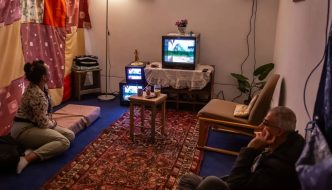Geometric Abstraction: Thoughts from the studio
November 26, 2014
[Images courtesy of Olivia Bambrough]
Ten till six, Monday to Friday, sees what feels like a lifetime’s worth of theoretical, practical and general musings developed in the studio space of a third year art student positioning themselves in an environment they will be, and to an extent already are, a part of. I am still pondering over my qualification to discuss theoretical, historical and formal motivations associated with my practice at this brink, most of all Geometry, which has unexpectedly began to edge (fitting) its way into my vicinity, giving my work the sense and purpose it has been craving.
Geometric Abstraction as a Contemporary practice in painting deals with the combination of pure two-dimensional and non-illusionistic (sometimes illusionistic) shapes to produce visuals that do not represent anything that can be found in nature. Although this method of working is undoubtedly Geometric, whether it adheres to the ‘requirements‘ of Abstraction is disputable. If Abstraction is non-narrational, non-figurative, non-objective and non-representative, then perhaps it could be argued that the justification of Geometric Abstraction as such lessens respectively. Geometric shapes are recognisable, identifiable and namable, regardless of their arrangement. Though, I do think this is perhaps a little finicky and consider Geometric Abstraction to be authentic if we remove it from an organic context and realise that it permutes the recognisable into the unrecognisable. It is non-imitational even though we might detect a square, a rectangle, a triangle, line or other.

Although I deem my own painting practice as Abstraction, it’s adherence to Geometric Abstraction has slightly crept up on me to the point where this is the first time I have addressed it head on. I realise that I am beginning to challenge the recognition associated with Abstraction and Geometry – both in different ways – and our urge to detect something that we can put a name too and consequently feel comfort in. By using known formal elements such as the grid or square in an irregular way, the relation of shape, precision and phenomenology can be challenged. Lines may be straight with the use of tape, but not necessarily parallel, so rectangles, squares, grids are not what they seem. Grids are also not a selection of intersecting lines, the kind associated with Modernism and Constructivism, but rather the layering of ‘material’, where every cell is different and repetition exposes variation. Geometry has the ability to be both supernal in its precision, yet somewhat organic in its fundamentality making it an interesting area to explore through painting.
German theorist and historian Wilhelm Worringer’s paramount work Abstract and Empathy (1908) provides an in depth and pragmatic discussion of the relationship between geometry and the psyche (if my slightly meandering thoughts have left you a little intrigued). It is packed full of thought-provoking content still incredibly relevant today, especially to student practitioners dabbling in Abstraction and considering the power of shape on sensibility. Although I think it is important to position yourself in a field as a student practitioner in order to see not only where you are, but where you’re heading, I do think categorisation can sometimes be limiting. Positioning can come during or after production, where recurrences and adherences emerge naturally.
Olivia June Bambrough




Comments